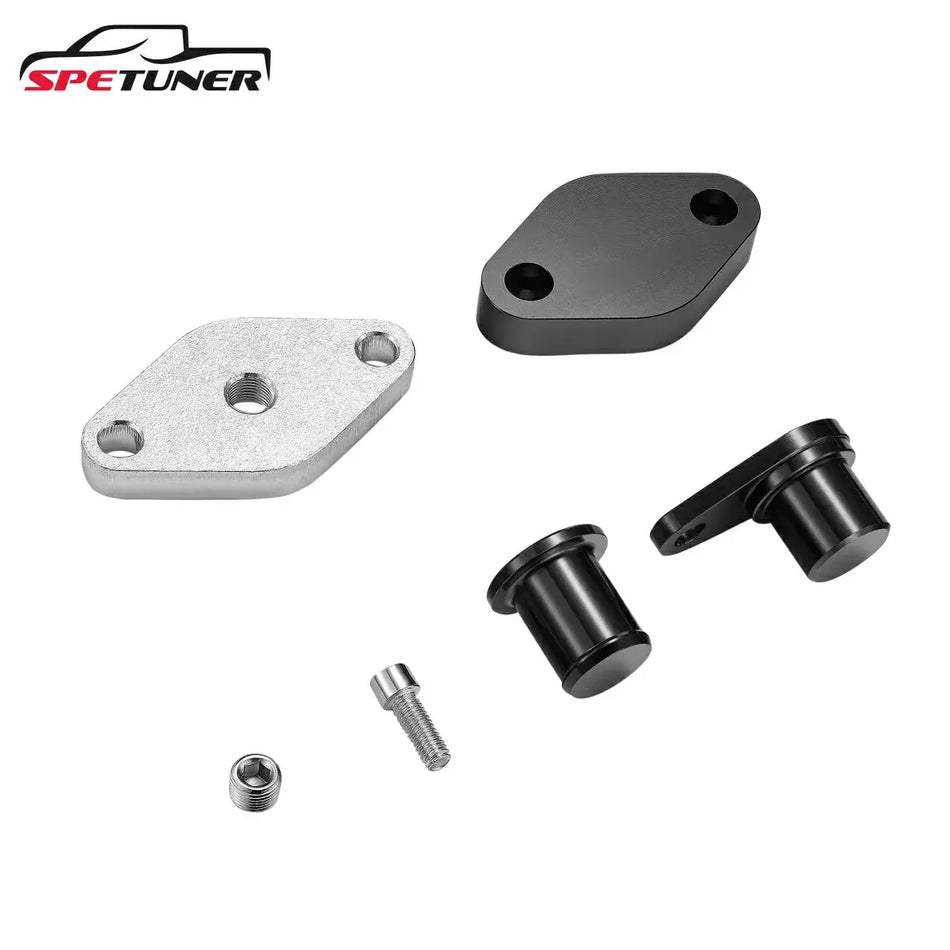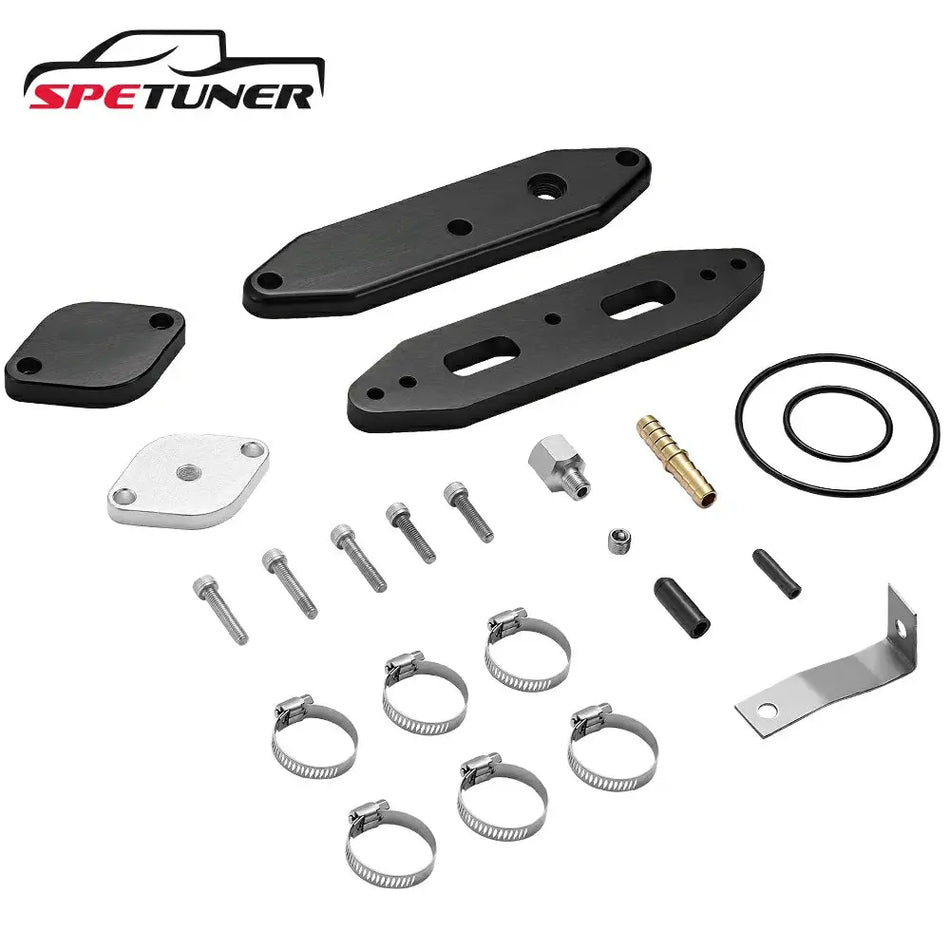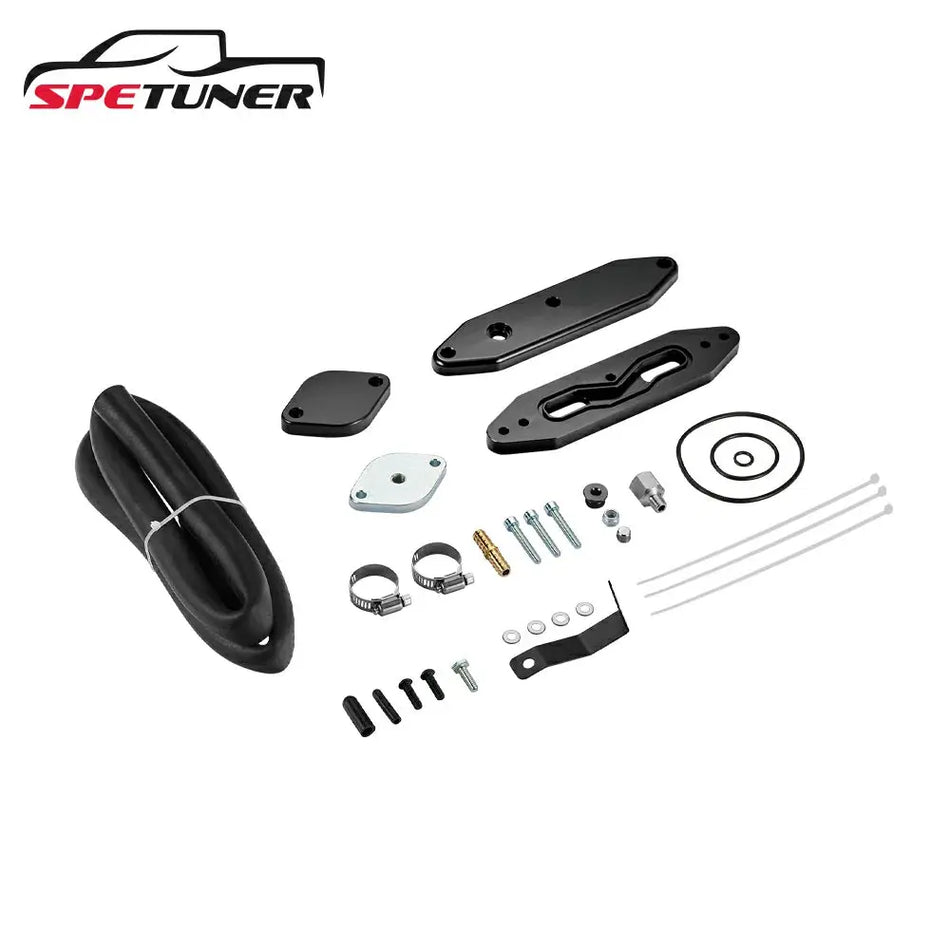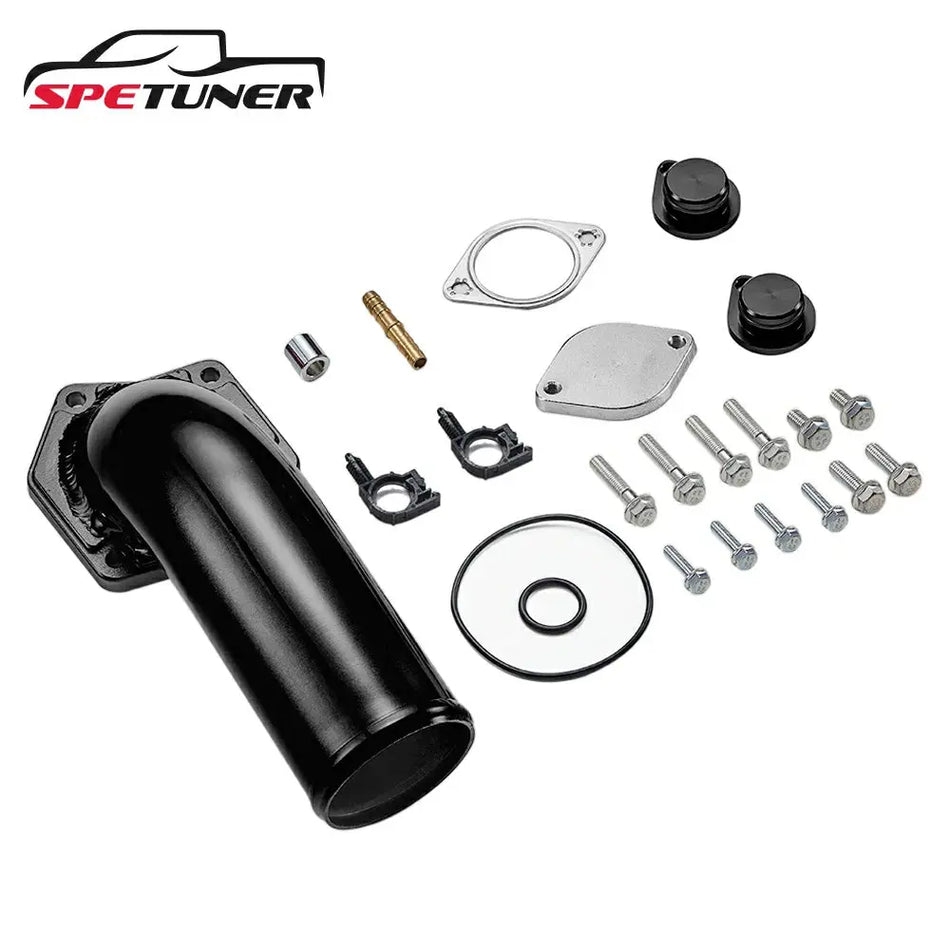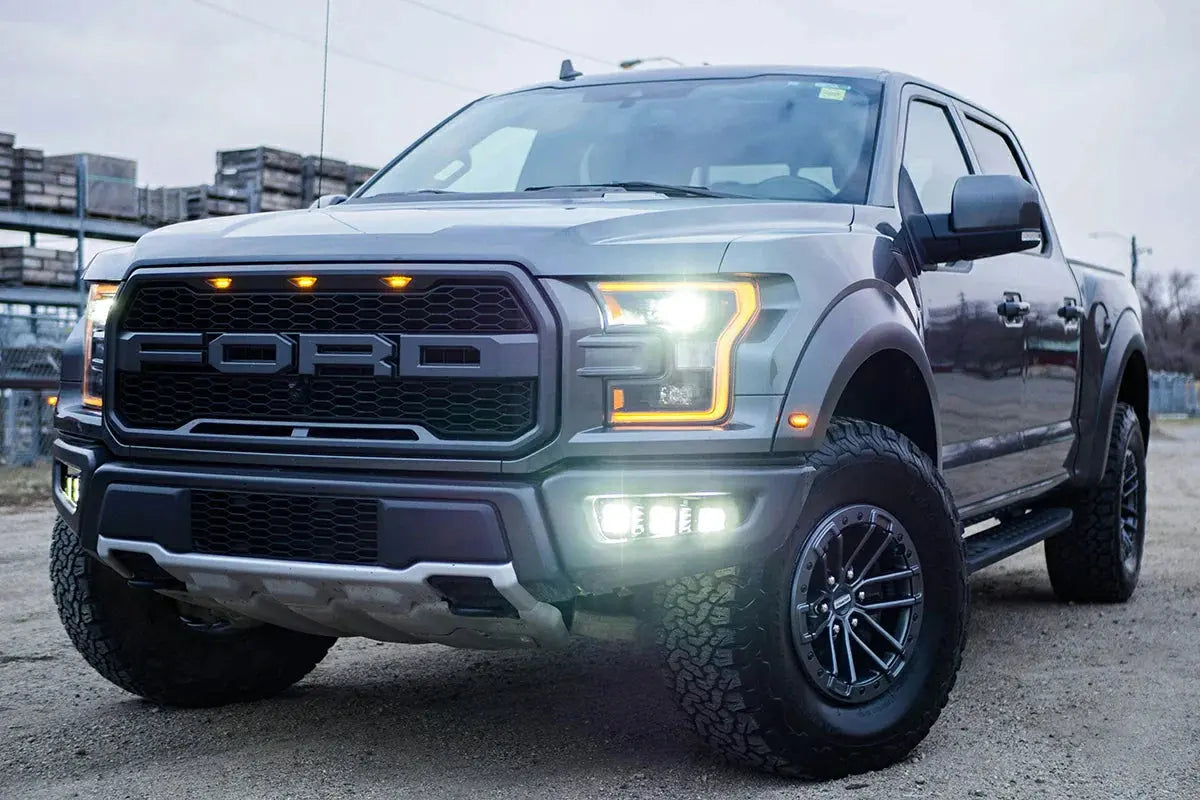Author's Bio: Hi, I’m Lars, a professional diesel truck enthusiast and an expert at SPETUNER, a leading manufacturer of automotive performance parts.
At SPETUNER, we specialize in performance kits for diesel vehicles, providing everything from intake systems to exhaust upgrades.
Whether you’re looking to increase horsepower or optimize fuel efficiency, I’m here to guide you through the details of L5P Duramax modifications.
👉 Looking for a complete solution? Check out our L5P Delete Kit – All-in-One with Tuning Included for everything you need in one package.
1. What Is an L5P Duramax Delete?
What Does L5P Duramax Deleting Involve?
If you’ve been considering deleting the emissions systems on your L5P Duramax, you’re likely aware of the power restrictions that come with the factory setup. So, what does it actually mean to “delete” these systems?
- DPF (Diesel Particulate Filter) Removal: The DPF captures harmful soot particles in the exhaust, which can cause backpressure and reduce engine efficiency. By removing it, your engine will breathe easier and experience less restriction, boosting both performance and fuel efficiency.
- EGR (Exhaust Gas Recirculation) System Removal: The EGR system sends exhaust gases back into the intake to reduce nitrogen oxide (NOx) emissions. While this reduces pollution, it also reduces engine efficiency and can cause carbon buildup. Removing the EGR system frees up power and reduces maintenance issues.
- DEF (Diesel Exhaust Fluid) System Removal: The DEF system uses a fluid to reduce NOx emissions by injecting it into the exhaust stream. While effective for emissions, the system can complicate maintenance and add to repair costs. Removing the DEF system simplifies your setup and eliminates the need for costly fluids.
These deletions aren’t just about removing parts — it’s about giving your Duramax more freedom to perform. Without the restriction of these emission systems, your engine can run more efficiently and with less stress.
Why Do Duramax Owners Consider Deleting?
For many Duramax owners, the main reasons to delete emissions systems come down to performance and long-term cost savings.
- Increased Power and Torque: Deleting restrictive systems like the DPF and EGR can lead to noticeable power gains, often resulting in an increase of 50–100 horsepower.
- Better Fuel Efficiency: With fewer components pulling energy from the engine, you may see improvements in fuel economy, especially on the highway.
- Reduced Maintenance: Emissions components can be prone to clogging and malfunctioning over time, which increases repair costs. Deleting them eliminates these potential issues, saving you money on repairs and parts.
By deleting your emissions systems, you’re giving your Duramax engine a fresh lease on life. It runs smoother, more efficiently, and with fewer potential problems.

2. The Benefits of Deleting an L5P Duramax
When you delete the emissions systems on your L5P Duramax, you’ll immediately notice several key benefits that directly impact both performance and long-term ownership costs. Let’s take a closer look at what those benefits are.
Performance Gains: Horsepower and Torque
One of the most significant advantages of deleting your L5P Duramax emissions systems is the noticeable improvement in engine performance. Without the restrictions of the DPF, EGR, and DEF systems, your engine can perform more efficiently, leading to a:
- Increase in Horsepower and Torque: The engine no longer has to fight against the backpressure from the DPF or the energy-sapping effects of the EGR system. Many owners report substantial increases in horsepower and torque after a proper delete.
- Better Throttle Response: A cleaner exhaust path and an optimized engine setup mean that your truck can accelerate faster, and you’ll feel more immediate power when you press the pedal.
This boost in performance can be felt on the road, whether you’re towing a heavy load or just driving around town. And, with the right custom tuning, you’ll unlock the true potential of your engine.
Improved Fuel Efficiency
Fuel efficiency is another key benefit that many L5P Duramax owners experience after an emissions delete. Removing the restrictive systems allows your engine to burn fuel more effectively, which can result in:
- Better Miles Per Gallon (MPG): With less exhaust restriction, your engine is more efficient, and fuel burns cleaner. Many truck owners see an improvement in fuel economy, especially during highway driving.
- Cost Savings Over Time: While the initial investment for the delete kit may seem high, the savings in fuel over the long term can quickly offset the cost of installation.
It’s not just about performance—deleting the emissions systems can also help you keep more money in your pocket by reducing your vehicle’s fuel consumption.
Reduced Maintenance and Repair Costs
Keeping your emissions systems intact can lead to costly repairs down the road. Components like the DPF and EGR system are prone to clogging and failure, especially in trucks that see heavy use or are driven in colder climates. By removing these systems, you’re likely to experience:
- Fewer Breakdowns: With no DPF or EGR to fail, your truck will run smoother, reducing the chances of costly repairs down the line.
- Lower Maintenance Costs: Maintenance tasks like cleaning the DPF or replacing faulty EGR valves can be expensive. With a delete, you won’t need to worry about these ongoing expenses.
For many truck owners, the reduced need for repairs is a significant reason to consider an emissions delete.

3. Breakdown of L5P Duramax Delete Costs
Now that you have a better understanding of the benefits, it’s time to break down the costs involved in deleting an L5P Duramax. This is where things can get a bit tricky, as prices can vary depending on the components you choose, the labor involved, and any custom tuning that may be necessary.
Before choosing parts or a tune, review the L5P delete kit comparison to pick the right setup for your model year.
Component Costs: EGR, DPF, and DEF Kits
When you delete the emissions systems, you’ll need specific parts to replace the factory components. Here’s a breakdown of the most common delete kits and their typical price ranges:
- EGR Delete Kit: This kit typically costs between $400 to $700. It removes the EGR valve and any associated parts, preventing the exhaust gas from re-entering the engine. This is one of the more affordable delete components.
- DPF Delete Kit: The DPF delete kit is a more expensive upgrade, with prices ranging from $700 to $1,200. It includes the parts needed to eliminate the diesel particulate filter, which is essential for improving exhaust flow and performance.
- DEF Delete Kit: For those who also want to remove the DEF system (the Selective Catalytic Reduction system), expect to pay between $200 to $400. This kit eliminates the need for diesel exhaust fluid, reducing complexity and maintenance.
Custom Tuning Costs
After deleting these systems, your truck’s engine needs to be reprogrammed to ensure it runs optimally without the emissions controls. This is where custom tuning comes in. Custom tuning costs can range from $600 to $1,200, depending on the complexity of the tune and the shop you choose. The tuning ensures that your engine runs smoothly without the deleted components and maximizes the power gains.
This is a crucial step—without proper tuning, your truck might run inefficiently, or worse, could suffer from engine damage due to miscalibration.
Cost Summary: Here’s a quick overview of the typical costs:
- EGR Delete Kit: $400 - $700
- DPF Delete Kit: $700 - $1,200
- DEF Delete Kit: $200 - $400
- Custom Tuning: $600 - $1,200
Don't forget the labor costs involved! Let’s talk about what to expect when it comes to professional installation. Keep reading!

For those who prefer to get the entire setup in one go, our All-in-One L5P Delete Kit includes DPF, EGR, DEF delete components and custom tuning in a single package.
4. Installation and Labor Costs
While the parts themselves are a major component of the cost, you also need to factor in labor costs for the installation of the delete kit. This can vary significantly based on the complexity of the job and the rates in your area, but I’ll give you a general idea of what to expect.
Labor Costs for Deleting an L5P Duramax
The labor costs for deleting the emissions systems on your L5P Duramax depend on a few factors:
- Experience and Expertise of the Shop: Shops with more experience in diesel performance modifications may charge a premium, but they can typically perform the job more efficiently.
- Location: Labor rates vary by region, so expect higher costs in major cities compared to rural areas.
On average, you can expect to pay between $500 and $1,500 for professional installation. This fee usually covers:
- Removing the old emission components (DPF, EGR, DEF)
- Installing the new delete components and any necessary hardware
- Performing any additional work, like exhaust rerouting, if needed.
Installation Time
Depending on the scope of the delete and the complexity of the setup, installation can take anywhere from 4 to 8 hours. If you’re having a custom tune done alongside the install, that may add additional time.
One thing to keep in mind: If you’re a DIY enthusiast and have the right tools, you can save on labor costs by doing the installation yourself. However, if you’re not experienced with diesel truck modifications, I always recommend leaving the job to a professional to avoid any issues down the road.
5. Legalities of Deleting an L5P Duramax
Before you start tearing apart your L5P Duramax to delete its emissions systems, it’s crucial to understand the legal implications. While the performance benefits are clear, the removal of emissions components can come with certain legal challenges depending on where you live.
Understanding Emission Regulations
In the United States and Canada, emissions regulations are very strict, especially in states or provinces with high pollution standards like California or Quebec. These areas have stringent rules regarding the modification or removal of any emissions control components, including the DPF, EGR, and DEF systems.
- Federal Law: Under the Clean Air Act in the U.S., it is illegal to tamper with emissions systems on vehicles that are driven on public roads. This means that deleting the DPF, EGR, or DEF systems technically violates federal regulations.
- State and Local Regulations: Some states, such as California, have even stricter laws and require vehicles to pass a state emissions inspection to be roadworthy. Deleting your emissions systems can cause you to fail these inspections and potentially face fines.
What About Off-Road Vehicles?
If you’re not planning to drive your L5P Duramax on public roads, the legal issues become less of a concern. Many truck owners opt to delete their emissions systems for off-road use only, especially in areas where they use their trucks for farm work, towing, or recreational purposes.
That said, if you ever plan to use your truck on public roads, you’ll need to make sure it passes emissions testing in your area. Some owners keep their stock emissions systems on hand to reinstall before inspections, while others use tuning devices that allow them to swap between stock and delete tunes when necessary.
6. Performance Tuning After Deleting Your L5P Duramax

After you’ve removed the DPF, EGR, and DEF systems from your L5P Duramax, the next crucial step is to tune your engine to ensure it runs optimally. Without proper tuning, your engine may experience issues like poor fuel efficiency, increased exhaust temperatures, and even engine damage over time. Here’s why tuning is so important after a delete:
Why You Need Custom Tuning
When you delete the emissions systems, your truck’s factory engine calibration becomes outdated. The vehicle’s ECU (Engine Control Unit) is no longer receiving data from these removed components, which can cause it to misfire or run inefficiently.
Custom tuning is necessary to:
- Optimize Air-Fuel Ratios: After the delete, your truck’s air-fuel mixture needs to be reprogrammed to ensure it runs smoothly without the emissions systems.
- Prevent Overheating: The EGR system helps regulate exhaust temperatures, so without it, the engine can run hotter. A good tune will adjust your engine’s cooling parameters to prevent damage.
- Maximize Power Gains: A properly tuned engine can unlock the full potential of your L5P Duramax’s increased airflow, providing better horsepower, torque, and throttle response.
Cost of Custom Tuning
Custom tuning is typically an additional cost, usually ranging between $600 and $1,200 depending on your truck’s setup and the tuning provider. This cost is a necessary investment to ensure that the delete doesn’t negatively affect your truck’s long-term performance.
Many professional tuners will provide a performance tune that is specifically designed for vehicles with deleted emissions systems. These tunes are developed to ensure your L5P Duramax performs at its best, and some tuners even offer multiple performance levels, depending on how aggressive you want the tuning to be.

7. Is an L5P Duramax Delete Worth It?
Now that you’ve got a clear picture of the costs, benefits, and legalities of deleting your L5P Duramax emissions systems, the big question remains: Is it worth it? As a professional who’s worked with many diesel truck owners, I can tell you that the answer depends on your goals, driving habits, and long-term plans for your truck.
When the L5P Duramax Delete Is Worth It
An emissions delete can be a fantastic option for truck owners who are looking to:
- Maximize Engine Performance: If you’re looking to extract every ounce of power from your L5P Duramax, deleting the emissions systems is one of the most effective ways to achieve that. It’s particularly beneficial if you regularly tow heavy loads or use your truck in demanding conditions.
- Reduce Maintenance Costs: The DPF and EGR systems are known to require a lot of maintenance, often resulting in costly repairs. Deleting them can save you money on parts and labor in the long run.
- Improve Fuel Economy: By eliminating the backpressure and inefficiencies created by the emissions systems, your truck may run more efficiently, saving you money on fuel over time.
If any of these reasons resonate with you, then an emissions delete might be exactly what your truck needs.
When It Might Not Be Worth It
However, there are certain situations where an emissions delete might not be the best decision:
- Strict Emissions Regulations: If you live in a region with stringent emissions testing requirements (like California or some areas in Canada), the legal risks and potential fines may outweigh the benefits.
- Short-Term Ownership: If you don’t plan on keeping your truck for the long haul, the upfront cost of the delete may not be worth it for the short time you own the vehicle.
- Environmental Concerns: Removing emissions systems can increase your vehicle’s environmental footprint, so if sustainability is a priority for you, this may not be the best choice.
Final Thoughts
An L5P Duramax delete offers impressive performance improvements and can reduce long-term maintenance costs, but it comes with legal and environmental considerations. It’s important to weigh the pros and cons carefully and make the decision that best suits your needs and goals.
If you're ready to proceed with your L5P Duramax emissions delete or need more guidance on the best kits and tuning options, feel free to reach out. Let’s get your truck performing at its best with SPETUNER’s premium performance parts and expert support.
Ready to delete your L5P? View our complete Duramax L5P delete kit to compare features, pricing, and included parts.
FAQs
Q1: How much does it cost to delete an L5P Duramax?
A1: The total cost to delete an L5P Duramax typically ranges from $2,000 to $4,000. This includes the cost of the delete kits (DPF, EGR, and DEF) which range from $1,400 to $2,300, and labor and tuning, which can add $500 to $1,500.
Q2: Can you delete an L5P Duramax?
A2: Yes, you can delete an L5P Duramax’s DPF, EGR, and DEF systems. However, be aware of the legal implications and the need for custom tuning to ensure your engine runs efficiently post-delete.
Q3: How much horsepower does a tuned and deleted L5P make?
A3: A tuned and deleted L5P Duramax can see significant gains in horsepower, often around 50 to 100 horsepower depending on the specific tune and delete kit installed.
Q4: What are the benefits of deleting the L5P Duramax?
A4: Deleting the emissions systems on an L5P Duramax offers several benefits: increased horsepower and torque, better fuel efficiency, reduced maintenance costs, and a more reliable engine setup without the constraints of emissions components.
Q5: Is deleting the L5P Duramax legal?
A5: Deleting emissions systems on an L5P Duramax is illegal for vehicles that will be driven on public roads in most regions due to emissions regulations. However, it can be legal if used solely for off-road purposes.
Q6: How long does it take to install a full delete on an L5P Duramax?
A6: The installation of a full delete kit, including the DPF, EGR, and DEF systems, typically takes between 4 to 8 hours, depending on the shop's experience and whether custom tuning is also required.
Q7: Can I do an L5P Duramax delete myself?
A7: While it is technically possible to perform an L5P Duramax delete yourself if you have the necessary tools and experience, I recommend leaving it to professionals to avoid mistakes and ensure proper tuning and installation.
Q8: Will my fuel economy improve after deleting my L5P Duramax?
A8: Yes, many truck owners report improved fuel economy after a delete, thanks to reduced exhaust backpressure and better engine efficiency. However, results can vary depending on driving conditions and the quality of your tuning.
Q9: Does deleting the L5P Duramax increase engine longevity?
A9: Deleting the emissions systems can reduce wear and tear on your engine by eliminating problematic components like the DPF and EGR, which are prone to clogging and requiring expensive repairs. However, proper maintenance and tuning are still essential for engine longevity.
Q10: What’s included in an L5P Duramax delete kit?
A10: An L5P Duramax delete kit typically includes the parts needed to remove the DPF, EGR, and DEF systems, along with any necessary exhaust rerouting parts and custom tuning files. Be sure to buy from reputable suppliers for quality parts and reliable performance.


